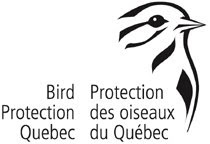Saturday morning March 31: I was joined by a group of 18 birders. Though the wind was very present along the St. Lawrence, the sun made the morning increasingly comfortable.
We started our trip at the Parc des Rapides, LaSalle. There we had about 35 Great Blue Herons standing on nests, and a member of the group also found a pair of Great Egrets, visible from one particular spot. They were also on a nest, but at lower height than the Great Blue Herons. At the entrance of the canal between Ile aux Hérons and Ile aux Chèvres, there were two Red-breasted Mergansers on the agitated water; two more were seen in flight. An interesting sighting was a lone Tree Swallow circling over Ile aux Chèvres, at a good height. In the meanwhile, a Double-crested Cormorant landed on the pond. Finally, as we left, a pair of Pileated Woodpeckers flew over us, stopped a minute on a tree and continued on to Ile aux Hérons.
From there, we drove east to two locations along the St. Lawrence River. First, stopping at the end of Crawford Street provided us with a nice group of 100 Common Goldeneye with some Bufflehead mixed in. Three birders found an hybrid Barrow's x Common Goldeneye that subsequently flew east and was not to be found again. That's when we started scanning the horizon to witness a major movement of geese, at a great distance, flying northeast. Although we could not distinguish individuals due to the distance, based on the pattern of the groups in flight, and the direction of the flight, we thought they were likely Snow Geese.
The second stop along the river led us in front of Douglas Hospital. There, a group of 120 Greater and Lesser Scaup (mainly Greater) was awaiting us. A Merlin flew by low and fast, just over our heads.
A subgroup of the initial group of birders continued from there to the Boisé de L'Île-des-Soeurs. We parked at the end of Boulevard de la Forêt.
There we were treated with different views of two Red-shouldered Hawks being mobbed by crows or circling over the woods in flight. One member of the group also found a bird perched on a distant tree, seen from the back.
At one point, we heard a very loud but brief song of a Carolina Wren. From then on we searched for the bird, and Vivek finally found it on the grass on someone's property, but at a good distance. We could make out the bird from its long tail cocked upwards at times, the overall color of the bird and the shape of the head. But finally the bird pearched on some wooded box, well in view, in the sun, and without moving for quite some time. We were then able to enjoy very good and satisfying views of the bird, which turned out to be a lifer for some of the birders.
We also had sightings of two Cooper's Hawks. One was first seen in flight. Later on, we found one bird that went on a tree and started plucking a songbird. That bird kept on giving one note calls. Then, a different Cooper's call (kek kek kek...) was heard nearby and a second bird soon joined the first. The first bird, presumably the male, left, and the second bird, presumably the female, took the food and also flew away.
Here is the complete list for the trip (40 species, plus one hybrid): Snow Goose (7500), Canada Goose (75), Gadwall (4), American Wigeon (2), Mallard (20), Greater Scaup (100), Lesser Scaup (10), Bufflehead (15), Common Goldeneye (100), Barrow's x Common Goldeneye (1), Common Merganser (12), Red-breasted Merganser (4), Pied-billed Grebe (1), Double-crested Cormorant (12), Great Blue Heron (40), Great Egret (2), Cooper's Hawk (2), Red-shouldered Hawk (2), Merlin (1), Ring-billed Gull (100), Herring Gull (10), Great Black-backed Gull (7), Rock Pigeon (5), Mourning Dove (1), Downy Woodpecker (12), Hairy Woodpecker (3), Pileated Woodpecker (3), American Crow (75), American Tree Sparrow (1), Black-capped Chickadee (17), White-breasted Nuthatch (1), Brown Creeper (9), Carolina Wren (1), American Robin (25), European Starling (50), Song Sparrow (25), Northern Cardinal (4), Red-winged Blackbird (150), Common Grackle (10), House Finch (3), American Goldfinch (1), House Sparrow (12).
Oie des neiges (7500), Bernache du Canada (75), canard chipeau (4), Canard d'Amérique (2), canard colvert (20), Fuligule milouinan (100), Petit Fuligule (10), Petit Garrot (15), garrots à œil d’or (100) , Barrow x garrots à œil d’or (1), Grand Harle (12), Harle huppé (4), Grèbe à bec bigarré (1), cormoran à aigrettes (12), Grand Héron (40), Grande Aigrette (2 ), Épervier de Cooper (2), Buse à épaulettes (2), Faucon émerillon (1), Goéland à bec cerclé (100), le Goéland argenté (10), Goéland (7), Pigeon biset (5), Tourterelle triste (1), Pic mineur (12), Pic chevelu (3), Grand Pic (3), Corneille d'Amérique (75), Bruant Hudsonien (1), Mésange à tête noire (17), Sittelle à poitrine blanche (1), grimpereau brun (9), Troglodyte de Caroline (1), Merle d'Amérique (25), Étourneau sansonnet (50), Bruant chanteur (25), Cardinal (4), carouge à épaulettes (150), Quiscale bronzé (10), Roselin familier (3), Chardonneret jaune (1), Moineau domestique (12).
Thank you everyone for coming and making such an enjoyable morning. Special thanks to David Mulholland for adding interesting comments on birds and their behaviour on many occasions. - Diane Demers
Monday, April 02, 2012
Subscribe to:
Post Comments (Atom)





No comments:
Post a Comment